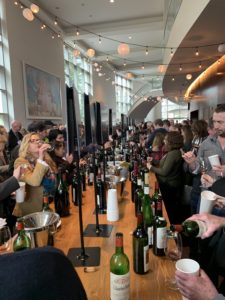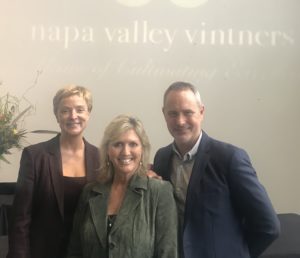From the Oral History Center Director:
David Pearson, CEO of the winery Opus One, said it something like this: Burgundy and Bordeaux have a deserved reputation for making some pretty good wines, but what sets these two French wine regions apart from and above the rest are their storied histories of making quality wine for generation upon generation. The wine itself is not only improved because of years of trial and error but the meaning of the wine is deepened because of the value placed on it by the people who have made and drunk it over hundreds of years. Pearson’s explanation was one of the highlights, for me, of the voices heard at the recent annual meeting of Napa Valley Vintners (NVV). I was invited to attend because we at OHC have partnered with the Vintners to do an oral history project documenting the history of the organization on the occasion of their 75th anniversary this year.

Pearson’s point was not lost on the several hundred vintners and others associated with Napa wine at the January 17th meeting. With over 150 years of continuous winemaking in the valley, many vintners in Napa are fully embracing the multiple benefits that come from knowing one’s history: from appreciating the moments of triumph to acknowledging and correcting one’s errors, from learning something new (and retaining it) during every vintage to recognizing that history might add literal market value to the wine. These points were brought to life during the reception that followed in which most every vintner brought from their own cellars Napa wines new and old to be shared. Seeing the lineup of hundreds of bottles produced over nearly 75 years provided ample evidence of the continuity of this history. But having the opportunity to taste a 1958 Charles Krug cabernet or a 1964 Inglenook cabernet (the last year it was produced by the legendary John Daniel, Jr.), was a great thrill as the wines have aged gracefully, wearing their decades in the bottle like badges of honor. You could taste the history.
The Oral History Center played a key role in what I think was another highlight of the event. Our very own David Dunham produced a video to open the proceedings: Just after the lights went down in the auditorium, a deeply accented Italian-American voice bursts from the speakers and the audience quickly goes silent, and listens. The voice is of Louis M. Martini, the famed California-by-way-of-Genova winemaker who established his winery in 1922 (yes, in the middle of Prohibition). Martini also was a founder of NVV and in this clip, from an interview conducted by OHC in the late 1960s, he recalls the impetus to establish the organization: “To eat and drink!” In the video, Martini is followed by another NVV founder, Robert Mondavi, who recounts how their agenda expanded into sharing winemaking best practices, dealing with government regulation, and promoting Napa Valley around the globe. Sitting in the middle of that auditorium, I was captivated by the voices on the screen, and pleased that the assembled crowd appeared to be soaking it up too. And the message they heard was that great things are possible when sometimes very independent-minded people decide to throw in together, recognize common purpose, and forge ahead with a shared belief in the value of what they are doing.

These wine industry interviews recorded as many as 50 years ago are now being augmented by a new effort by the Oral History Center to document the history of the California wine industry. One part of this broader effort is a project of a dozen interviews looking at the history of NVV but I hope that we can build a bigger, broader project as well. As I conduct these interviews, it is not difficult to think about the role of the interviewer too. I am thankful that Ruth Teiser, the woman who conducted most of those early wine history interviews, saw the value of this topic and took the considerable time needed to ask the questions and capture the voices of these key figures. Most of her narrators are now gone but they still speak to our generation, and generations to come.
To help document this long, fascinating, and, yes, important history, we are actively seeking partners and sponsors, ideas and information. So, if this project sounds interesting to you and you want to help us make it happen, please contact me. Let’s sit down over a glass of wine and talk about the remarkable history of wine in California and the promise that lies ahead.
Martin Meeker, Charles B. Faulhaber Director